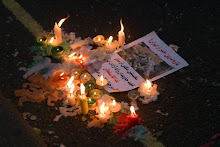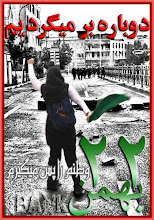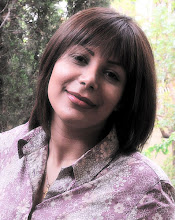Jackpot!!! A veritable treasure chest of C words to add to the ever-expanding list. Ceramics in the City is now affectionately known at C in the C and Confrontational Ceramics, a vast glossy tome, was sent to me by Ceramic Review, with a request to review the book in 1000 words. With this request I have gladly complied, and I can let you know, in advance of publication, that my review is almost 900 words longer than the text of the book. Ok, slight exaggeration, but suffice to say, it’s yet another of those unspeakable survey books, packed to eaves with hideously glossy pictures and littered with ‘artists’ statements,’ each more turgid than the Journal of Psychiatry.
American Acronyms
So, lets get back to the Credit Crunch. Now it seems that this phenomenon has not yet hit Hackney. Almost everywhere else in the world in now affected: 11 banks in the USA have gone bust, 2 in the UK, President Bush will henceforth be known as the Supreme Leader of the Union of Soviet Socialist States of America, and Maggie May and Donald Duck are building a straw-bale barn somewhere near you where they will swim in the local WAMU and lay AIGs. I’m sure I shouldn’t be so flippant but what else can one do?
Ceramics in the City
Getting back to Hackney, this is where the Geffrye Museum is located, in Kingsland rd, and where the eighth outing of Ceramics in the City bustled with buyers who did, by all accounts, buy. I didn’t get there this year, but I have this information on good authority. All the makers I’ve asked so far have told me it was very well attended and business was brisk. Although results varied for each maker, all have said it was better than most other years. This event took place on the 19th, 20th and 21st of September, the weekend after the announcement of the take over of HBOS by Lloydstsb, which will result in the loss of at least 140,000 jobs and an almost complete collapse of the stock market. Add to that the nationalisation of Northern Rock, near collapse of Bradford and Bingley, rescued by nationalisation, the loss of thousands of jobs when Lehman’s went under and you wonder how it is we’re still selling anything at all. So, encouraging though C in the C’s results obviously are, I am wondering if we shouldn’t all be diversifying – into what I haven’t quite decided, but all imaginative suggestions will be considered.
Just checked google for the spelling of Lehman’s, and found a site, also called Lehman’s in Ohio, which sells butter lamps (ok, oil lamps, but they can easily be converted) and wood burning stoves. I think we might be on to something here.
Lasting vs Disposable
So why are people cheerfully buying handmade pottery at this time, when most of us are facing a winter without heating because we can’t afford the bills, a great may people will be losing their jobs, still more are paying higher interest on their mortgages, others paying higher rents because of competition in the private rented sector because, if you’re on a modest income, you haven’t got a hope in hell of getting a mortgage, and so on? Perhaps longevity is suddenly appealing. Hand made tableware is the very embodiment of the polar opposite of both disposable and conspicuous consumerism. I emphasise handmade tableware because this is what C in the C showcases, arguably, better than any other event I can think of. It also showcases the domestic side of craft, immensely elegantly. The Geffrye is the Museum of the domestic interior, so domestic pottery sits particularly well here.
Terraced Industries
C in the C is a nest of urban potters, many of whom are Londoners. They are experts in ‘old fashioned’ skills such as throwing, (colloquial pottery expression: it means making pots using a potters wheel) and this in itself is unusual these days. Many work full time as potters. They are running what used to be called ‘cottage industries.’ These have now migrated to the city and become ‘terraced industries.’ I suspect such industry could not survive economically in rural areas. Caveat here – Nick Membery is bucking this trend. He has a sophisticated internet selling mechanism, which none of the terraced industry potters do, as far as I know. So I guess his is really, ‘small industry.’ So, in our upside down world of Socialist America with its nationalised banks we can add smart terraced industry migrating to the country, to rural Wales in fact, and peasant industries thriving in Stoke Newington. Now all we need is Serbia to become the world leader in Islamic banking and England to win the world cup. Then I’ll have to go out and buy a new brain, the old one isn’t going to cope.
And Finally...
So, just to acknowledge the last C in the title of this post, are we witnessing the Collapse of global Capitalism? It’s got to be a change in the old world order, surely. I have a feeling it’s not going to be a very comfortable one. I’ve got used to my creature comforts. I’m getting the shed tarted up this week. Just in case a proliferation of C words is the only jackpot I’m going to win.
Sunday, 28 September 2008
Monday, 15 September 2008
Tottenham Flower Show, 2008









After all my proclaiming that a Tottenham Flower and Produce Show would be a very fine thing, if only someone would organise it, I find I’m behind the times. Someone has organised it. It started last year. Imagine my excitement. No more that 30 metres from my very own front door, September 13th, 2008, was the very flower show I yearned for, complete with tents, band, (wonderful Irish dance music), and tea tent.
The exhibition tent was THE BUSINESS. Packed to the eaves with enthusiastic citizens anxiously awaiting the announcement of the first prizes, the trestle tables fairly groaned under the weight of sponge cakes, loaves of bread, fruit pies, chutneys, jams, honey, knitted and crocheted items of many kinds, quilts, bunches of herbs. Eat yer hearts out sour-faced estate agents, police, taxi drivers and all you other miserable sods who always run Tottenham down at any opportunity! Come and see what we can make! There were donkey rides, a dog show and the paddling pool was clean and glistening for Tottenham’s youngsters. The tea tent was a bit small and understaffed, but the teas and cakes were the best I’ve had in years. Sorry Wootton, you were outclassed I’m afraid. We even had a broderie-anglaise table cloth for the communal trestle table. So there!
Urban or Rural?
If Wootton is really a suburb, what does this make Tottenham? Is it an urban village, is it also a suburb? I don’t think either description fits. To me, Tottenham feels like a small town which has somehow got itself muddled up with London. The show is in its infancy and has a few ‘teething problems’ – such as the too small tea tent - where are the WI when you need them? I have high hopes however. I suspect it will be a much bigger do twenty years from now. I’d like to see much more participation from some of Tottenham’s newer populations, such as the Kurdish ladies I’ve mentioned elsewhere on this blog, who do the magnificent sewing. There is something about this kind of occasion that provides exactly the right context for craft, in the sense that it becomes ‘home craft’ again and, in an instant, all that craft agonising is removed.
So, in keeping with that spirit, the C Word is awarding ‘best in show’ again and, on this occasion, it goes to the woman who made the knitted shopping bag out of those beastly blue carrier bags that every corner shop uses – she’d knitted the bags together. BRILLIANT!!! I loved it. Pictures above. So that’s it for this summer. The C Word is back from holiday and open for business from now on.
See you very soon with a short comparative review of two shows which opened on September 11th, Richard Slee at Barratt Marsden, and Elspeth Owen at the Hart Gallery.
Friday, 5 September 2008
Cabbages and Quilts: The Wootton Flower and Produce Show, 2008.













Cabbages and Quilts: The Wootton Flower and Produce Show, 2008.
Ra tatataaaaaa, drum rolllllll, ratatat, dum diddle dum diddle dum dum dum. Intermittent strains of brass band music twirl around tents and idling teenagers, village elders and passing visitors, all of whom milled about the glistening green lawns and drifted in and out of immaculate white tents at this year’s village flower show. If ever there was an act of faith, a testament to optimism it was this. A rain drenched, wind swept, dripping cold August had put aside one fine day, Saturday 30th, for Wootton’s annual extravaganza of cabbages and cakes. Apples and preserves, cable knitted cardies, quilts and roses, all expertly assembled, jostled for position on their tables, and were justly, or unjustly, rewarded. An incident over the gladioli was duly calmed, the wasps sought refuge in the prize-winning cake, and everyone delighted in the glorious sunshine which bathed the tents and lawns and gardens all day.
So here it is, an authentic village flower show, which, as far as I can see, is still pretty much as it was 40 years ago, when I won first prize for a painting, aged 6. No one’s gone out of their way to insist in its unchanging state. It just hasn’t changed. Of course the people have. I’ve drifted off to London and the village has been almost entirely repopulated but the flower show still has runners and beets and marrows and carrots and ‘garden on a plate’. My niece made a mangrove swamp one year. She’s still feeling misunderstood because she didn’t win a prize. She’s 21 now. The ‘home craft’ is still astounding. It doesn’t seem even slightly naff to me, not in this context. It’s quite at home here. The exquisite smocking is for someone’s new baby, the tea cosies are for teapots, the quilts for someone’s bed, the knitted cardies will be worn, the wooden toys played with. I know, it all sounds too idyllic, but it is true. I don’t quite know how it is that people have the time, but the work is here to prove it. They’re not trying to make a living from it, which helps, but it’s all made for a purpose.
This should not be mistaken for ‘rural’ craft. Certainly Wootton is a village and is in ‘the country’. It is, however, a suburb in character, but one that is detached. It is one of the wealthiest areas in England now and its economy is entirely urban. No one goes to work in the village. Everyone who lives there works in neighbouring cities. The place is deserted during the day, apart from the school – ah ha, so there are teachers who work in Wootton, and as very small number of people who come to clean houses and maintain gardens. So Wootton flower and produce show is a product of urban – not always wealth, but stable income - combined with a mixture of creative domestic activity, good gardeners, - and these are the ones cared for by the owners, not paid gardeners, - and an industrious spirit – oh and a touch of neighbourly competitiveness. Tottenham flower and prod show would be very similar. There are enough people with a stable income to fund the creative domestic activity, a wealth of domestic skill, and we even have the ‘country’ house, - Bruce Castle – which can compete with any in the land – and we have the 400 year old oak trees. It would just be a more multi-cultural that’s all.
As to craft, village craft vs. gallery craft, well – craft it seems becomes a problem requiring scrutiny, only when it departs from the flower show and from that use/comfort/decoration mix to something that either questions itself and what it’s doing in an industrialised society or when it is used as a medium to explore ideas which are part of its habitus, probably, but not part of it usual or original social role.
This seems like a good place to leave this post which serves, I think, as a good introduction to the next series of posts which will talk about Ceramics in the City, Origin and so forth, as well as a fond farewell to the summer holiday – such as it was.
Subscribe to:
Comments (Atom)











































